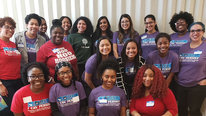
KATHRYN WILLIAMSON
FIRST TWO: Improving STEM Persistence in the First Two Years of College
NSF Awards: 1649323
2017 (see original presentation & discussion)
Undergraduate
Many of West Virginia’s college students come from rural areas and are the first in their families to pursue a higher degree. However, attending college disconnects students from their tight-knit hometown support systems, and very few persist beyond their first two years of college. To better understand the barrier of persistence and to solve the problem of attrition, the FIRST TWO INCLUDES Project brings together Community College and University leaders, National Lab STEM professionals, and Rural Education experts. Our plan is to integrate early experience in STEM internships, online communities of practice, and STEM skills development into a discovery-based "principles of research and development" college seminar for first year students. Our goal is for the course to be transferrable such that it can be scaled to institutions around West Virginia and across the Appalachian region. By re-framing the connection to home as an asset, we will sustain engagement through a second service learning course called “STEM Leadership.” The FIRST TWO “Hometown Ambassadors” who take this course will develop communication skills and will mentor younger students. They will go back to their hometowns to reach out to students they actually know and work with teachers and school board members of the schools they attended, thereby becoming agents of change in their own communities. Because of the FIRST TWO project, we will be able to determine the feasibility of a National STEM Persistence Alliance that partners National Lab internship programs with 2 and 4-year schools who serve First Generation College students.
Related Content for FIRST TWO: Improving STEM Persistence in the First Two Years
-
 2020Student Voice: Solving the Puzzle of STEM Persistence
2020Student Voice: Solving the Puzzle of STEM Persistence
Sue Ann Heatherly
-
 2018S-POWER Engineering Pathways for Transfer students
2018S-POWER Engineering Pathways for Transfer students
Claire Duggan
-
 2022Engineering Success for Transfer Students
2022Engineering Success for Transfer Students
Claire Duggan
-
 2022Preparing STEM Teachers for Rural Places
2022Preparing STEM Teachers for Rural Places
Earl Legleiter
-
 2017Caminos a la Ciencia - Pathways to Science
2017Caminos a la Ciencia - Pathways to Science
April Marchetti
-
 2019STEM research driven by students’ own funds of knowledge
2019STEM research driven by students’ own funds of knowledge
Laleh Cote
-
 2022Redesigning Gateway Mathematics at a Two-Year HSI
2022Redesigning Gateway Mathematics at a Two-Year HSI
Mary Pilgrim
-
 2022Centering Women of Color in STEM: The ICP STEM Initiative
2022Centering Women of Color in STEM: The ICP STEM Initiative
Kerrie Wilkins-Yel
Marcelo Worsley
Assistant Professor
I like how this project is looking to utilize students as ambassadors that can help build and sustain a community of rural first generation college students. I'm also glad to see that you are thinking about both in person and online opportunities for students to engage with others. I think this is important to helping them stay connected. It will also be neat to see how growing this community of scholars will help reshape traditional notions of STEM, and also bring cutting edge STEM ideas to different rural communities.
Kathryn Williamson
Teaching Assistant Professor
Thank you, Marcelo! We do feel that one of the greatest strengths of our project is that we elevate the voices of those the project serves right from the beginning.
Marcelo Worsley
Assistant Professor
Are there existing resources that support students in their 3rd and 4th years? Perhaps after two years of support students will have developed a strong enough support/professional network to sustain them through their final years?
Additionally, have you had any anecdotal feedback from parents about this program?
Michael Lach
Director of STEM Policy and Strategic Initiatives
This seems like such important work--thank you! I'm wondering what sorts of knowledges/skills/dispositions you find are most helpful (or most easily develop-able) for the ambassadors. Seems like they're at the heart of this work, and many others will be curious what you find helps them most.
Lauren Amos
Associate Director
I love, love, love the hometown ambassador component of your program! I've worked with a number of organizations over the years that struggled to implement a similar idea for their first-generation college students. It's nice to learn of a model that is working. In my experience, students from rural communities and first-generation college students often find attending 2-year colleges less intimidating. Has this been the case for your students? Is counseling students about the various academic and career pathways to a STEM career a part of your program (e.g., earning certificates, transitioning to a four-year university, pursuing summer internships)?
Further posting is closed as the event has ended.